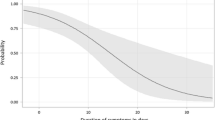Abstract
Introduction
The aim of the study was to identify risk factors of failed two-stage procedures in cases of chronic posttraumatic periprosthetic hip infections.
Patients and methods
Between 2006 and 2008, 26 patients with chronic posttraumatic periprosthetic infections after hip arthroplasty were included. In all cases operative bacterial eradication was initiated. The therapy was carried out according to a standardized treatment protocol including the eradication of the bacterial infection and the prosthetic replacement after three negative intra-operative specimens as a two-stage procedure. Follow-up was performed at least 2 years after revision procedure.
Results
Twelve patients showed no signs of infectious recurrence 2 years after prosthetic hip revision therapy (46 %) and were assigned to group I. Group II is constituted by the other 14 patients (54 %). Four of them (16 %) suffered from an infectious recurrence after prosthetic hip replacement, ten patients (38 %) were characterised by a failed bacterial eradication. The spectrum of pathogens showed a significantly higher resistance pattern (p = 0.001) in group II, with a majority of methicillin-resistant Staphylococcus epidermidis (MRSE) and highly resistant Pseudomonas. In addition, patients of group II offered significantly higher American Society of Anesthesiology (ASA) scores (p = 0.015), the body mass index (BMI) was significantly elevated (p = 0.031) and received a significantly higher number of operative procedures (p = 0.016).
Conclusions
A reduced general state of health, a high BMI and highly resistant pathogens are the main risk factors for a failed two-stage procedure after chronic posttraumatic periprosthetic hip infections. Therefore, different treatment strategies are required for a defined subgroup of patients.





Similar content being viewed by others
References
Garvin KL, Hanssen AD (1995) Infection after total hip arthroplasty. Past, present, and future. J Bone Joint Surg Am 77(10):1576–1588
Went P, Krismer M, Frischhut B (1995) Recurrence of infection after revision of infected hip arthroplasties. J Bone Joint Surg Br 77(2):307–309
Kilgus DJ, Howe DJ, Strang A (2002) Results of periprosthetic hip and knee infections caused by resistant bacteria. Clin Orthop Relat Res 404:116–124
Militz M, Buhren V (2010) Replacement of infected knee and hip endoprostheses. Chirurg 81(4):310–320
Brown TD, Johnston RC, Saltzman CL et al (2006) Posttraumatic osteoarthritis: a first estimate of incidence, prevalence, and burden of disease. J Orthop Trauma 20(10):739–744
Cordero-Ampuero J, de Dios M (2010) What are the risk factors for infection in hemiarthroplasties and total hip arthroplasties? Clin Orthop Relat Res 468(12):3268–3277
Ridgeway S, Wilson J, Charlet A et al (2005) Infection of the surgical site after arthroplasty of the hip. J Bone Joint Surg Br 87(6):844–850
Wodtke J, Lohr JF (2008) The infected implant. Orthopade 37(3):257–267, quiz 268–259
Hanssen AD, Spangehl MJ (2004) Practical applications of antibiotic-loaded bone cement for treatment of infected joint replacements. Clin Orthop Relat Res 427:79–85
Mahomed NN, Barrett JA, Katz JN et al (2003) Rates and outcomes of primary and revision total hip replacement in the United States medicare population. J Bone Joint Surg Am 85A(1):27–32
Raut VV, Orth MS, Orth MC et al (1996) One stage revision arthroplasty of the hip for deep gram negative infection. Int Orthop 20(1):12–14
Biring GS, Kostamo T, Garbuz DS et al (2009) Two-stage revision arthroplasty of the hip for infection using an interim articulated Prostalac hip spacer: a 10- to 15-year follow-up study. J Bone Joint Surg Br 91(11):1431–1437
Yoo JJ, Kwon YS, Koo KH et al (2009) One-stage cementless revision arthroplasty for infected hip replacements. Int Orthop 33(5):1195–1201
Hanssen AD, Spangehl MJ (2004) Treatment of the infected hip replacement. Clin Orthop Relat Res 420:63–71
Bourne RB, Hunter GA, Rorabeck CH et al (1984) A six-year follow-up of infected total hip replacements managed by Girdlestone’s arthroplasty. J Bone Joint Surg Br 66(3):340–343
Kantor GS, Osterkamp JA, Dorr LD et al (1986) Resection arthroplasty following infected total hip replacement arthroplasty. J Arthroplasty 1(2):83–89
Castellanos J, Flores X, Llusa M et al (1998) The Girdlestone pseudarthrosis in the treatment of infected hip replacements. Int Orthop 22(3):178–181
Wagner H, Wagner M (1995) Infected hip joint prosthesis. Viewpoints for 1-stage and 2-stage prosthesis exchange. Orthopade. 24(4):314–318
Berbari EF, Hanssen AD, Duffy MC et al (1998) Risk factors for prosthetic joint infection: case-control study. Clin Infect Dis 27(5):1247–1254
Moyad TF, Thornhill T, Estok D (2008) Evaluation and management of the infected total hip and knee. Orthopedics 31(6):581–588, quiz 589-590
Whittaker JP, Warren RE, Jones RS et al (2009) Is prolonged systemic antibiotic treatment essential in two-stage revision hip replacement for chronic Gram-positive infection? J Bone Joint Surg Br 91(1):44–51
Lieberman JR, Callaway GH, Salvati EA et al (1994) Treatment of the infected total hip arthroplasty with a two-stage reimplantation protocol. Clin Orthop Relat Res 301:205–212
Hanssen AD, Osmon DR (2000) Assessment of patient selection criteria for treatment of the infected hip arthroplasty. Clin Orthop Relat Res 381:91–100
Jackson WO, Schmalzried TP (2000) Limited role of direct exchange arthroplasty in the treatment of infected total hip replacements. Clin Orthop Relat Res 381:101–105
Lim SJ, Park JC, Moon YW et al (2009) Treatment of periprosthetic hip infection caused by resistant microorganisms using 2-stage reimplantation protocol. J Arthroplasty 24(8):1264–1269
Klima S, Zeh A, Josten C (2008) Reimplantation of a hip prosthesis in patients with an infected resection arthroplasty. Z Orthop Unfall 146(5):616–623
Conflict of interest
The authors declare that they have no conflict of interest.
Author information
Authors and Affiliations
Corresponding author
Rights and permissions
About this article
Cite this article
Spiegl, U., Friederichs, J., Pätzold, R. et al. Risk factors for failed two-stage procedure after chronic posttraumatic periprosthetic hip infections. Arch Orthop Trauma Surg 133, 421–428 (2013). https://doi.org/10.1007/s00402-012-1673-6
Received:
Published:
Issue Date:
DOI: https://doi.org/10.1007/s00402-012-1673-6




